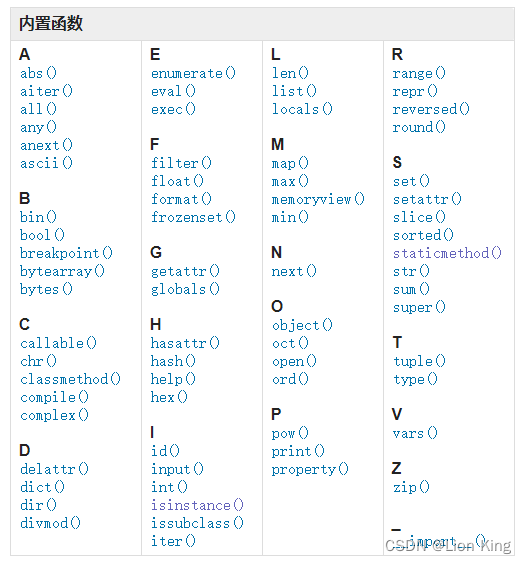一、官方网址
内置函数 — Python 3.10.1 文档https://docs.python.org/zh-cn/3.10/library/functions.html#isinstance

二、实验
# A
print(abs(-1)) # 1
print(abs(1.265)) # 1.265
print(abs(1+1j)) # 1.4142135623730951
# ai = aiter([1,2,3,4,5,6]) # 只支持3.10版本,用法与iter类似
# print(next(ai))
print(all([0,1,2,3,4,5,6])) # False, 全为真时输出才是True
print(all([1,2,3,4,5,6])) # True
print(any([0,1,2,3,4,5,6])) # True, 任意一个为真时输出就是True
print(any([0,0])) # False
print(ascii("我[0,0]我")) # '\u6211[0,0]\u6211',转化成ASCII 字符,非 ASCII 字符会用 \x、\u 和 \U 进行转义。
# B
print(bin(5)) # 0b101, 将整数转变为以“0b”前缀的二进制字符串。
print(bool([0,1,2,3,4])) # True
# breakpoint() # 断电,程序执行到这个地方时会停止,等待调试人员输入指令
print(bytearray("12345,上山打老虎!", encoding="utf-8")) # bytearray(b'12345,\xe4\xb8\x8a\xe5\xb1\xb1\xe6\x89\x93\xe8\x80\x81\xe8\x99\x8e\xef\xbc\x81')
print(bytes("12345,上山打老虎!", encoding="utf-8")) # b'12345,\xe4\xb8\x8a\xe5\xb1\xb1\xe6\x89\x93\xe8\x80\x81\xe8\x99\x8e\xef\xbc\x81'
# C
def b():
pass
print(callable(123)) # False, 如果参数 object 是可调用的就返回 True,否则返回 False。
print(callable(b)) # True
print(chr(97)) # a, 返回 Unicode 码位为整数 i 的字符的字符串格式。
class C:
@classmethod # classmethod()的使用方式
def f(cls, arg1, arg2):
print("nice")
c = compile("for i in range(0,2): print(i)",'','exec') # 首先编译为字节代码对象(exec对象)
print(c)
exec(c) # 0,1 ,再通过该种类的编译器去执行
print(complex(1,2)) # (1+2j)
# D
setattr(C, "name", "猪坚强")
print(C.name) # 猪坚强
delattr(C, "name")
print(dir(C)) # 不再有name属性
print(divmod(1, 2)) # (0, 1), 返回(商,余数)
# E
for index,value in enumerate([1,2,3,4]):
print(index,value) # 0 1, 1 2, ...
print(eval("[1,2,3]")) # [1, 2, 3], 执行字符串中的语句(单条执行)
exec('''
print("我是exec")
C().f(1,2)
''') # 执行字符串中的语句(批量执行)
# F
print(list(filter(lambda x: x%2==1, [1,2,3,4]))) # [1, 3]
print(float(0)) # 0.0
print(format("12345", "1<10")) # 1234511111,填充为10个字符,并且以“1”填充
print(frozenset({1,2,3,3,3})) # 不可变集合
# G
print("-----------------分界线--------------------")
def g():
gg = 123
print(globals()) # 全局变量字典,但对于函数内部的值只返回对象 : {'__name__': '__main__', '__doc__': None, '__package__': None, '__loader__': <_frozen_importlib_external.SourceFileLoader object at 0x000001438A5F08E0>, '__spec__': None, '__annotations__': {}, '__builtins__': <module 'builtins' (built-in)>, '__file__': 'D:/pycharm/Projects/viscanner_interface/common/mytest001.py', '__cached__': None, 'b': <function b at 0x000001438AAC2160>, 'C': <class '__main__.C'>, 'c': <code object <module> at 0x000001438AB40710, file "", line 1>, 'i': 1, 'index': 3, 'value': 4, 'g': <function g at 0x000001438AAC21F0>}
# H
class H:
name = "123"
print(hasattr(H, "name")) # True, 如果字符串是对象的属性之一的名称,则返回 True,否则返回 False。
print(hasattr(H, "www")) # Flase
print(hash(H)) # 返回一个hash值
help(H) # 查看帮助文档
print(hex(123)) # 0x7b, 将整数转换为以“0x”为前缀的小写十六进制字符串。
# I
print(id(H)) # 返回内存中该对象的唯一ID
# s = input('--> ') # 输入什么则展示什么
# print(s)
print(int("10"))
print(isinstance("123",str)) # True, 判断类型
print(isinstance("123",int)) # False
class H1(C):
pass
print(issubclass(C,H)) # False
print(issubclass(C,H1)) # False
print(issubclass(H1,C)) # True
it = iter([1,2,3,4,5])
print(next(it)) # 1
# L
print(len([1,2,3,4,5,0,0,0])) # 8
print(list("[1,2,3,4]")) # ['[', '1', ',', '2', ',', '3', ',', '4', ']']
print(locals()) # 更新并返回表示当前本地符号表的字典。 在函数代码块但不是类代码块中调用 locals() 时将返回自由变量。
def df1():
a001 = 999
print(locals())
df1() # {'a001': 999}
print(list(map(lambda x: x ** 2, [1, 2, 3, 4, 5]))) # [1, 4, 9, 16, 25], 返回一个将 function 应用于 iterable 中每一项并输出其结果的迭代器。
# M
print(max([1, 2, 3, 4, 5])) # 5
print(max([1, 2, 3, 4, 5], [10, 20, 30, 40, 50])) # [10, 20, 30, 40, 50]
print(min([1, 2, 3, 4, 5])) # 1
print(min([1, 2, 3, 4, 50], [10, 20, 30, 40, 5])) # [1, 2, 3, 4, 50]
print(next(it)) # 2
# O
print(oct(123)) # 0o173 , 将一个整数转变为一个前缀为“0o”的八进制字符串。
# open("../files.txt") # 打开文件
print(ord('a')) # 97
# P
print(pow(2, 5)) # 32, 返回 2 的 5 次幂
print("hi, 我是print")
class P():
@property
def p1(self):
return 1
def __repr__(self):
return "[1,2,3]"
print(P().p1) # 1, 将函数变属性
# R
print(range(2)) # range(0, 2)
print(repr(P)) # 返回对象的可打印形式字符串。
print(repr({'runoob': 'runoob.com', 'google': 'google.com'})) # 字符串 {'runoob': 'runoob.com', 'google': 'google.com'}
print(list(reversed([1,2,3,4,5]))) # [5, 4, 3, 2, 1]
print(round(5.5)) # 6, 四舍五入
print(round(-0.5)) # 0
# S
print(set("1,2,3")) # {',', '3', '1', '2'}, 返回可变集合
setattr(P, "name", "value") # 设置属性值
print(P.name) # value
print(slice(5)) # slice(None, 5, None)
print([1,2,3,4,5,6,7,8,9][slice(5)]) # [1, 2, 3, 4, 5]
print(sorted([1,2,3,4,5], key=None, reverse=True)) # [5, 4, 3, 2, 1]
class S(object):
@staticmethod
def s001():
return 1
print(S.s001()) # 1
print(str([1,2,3,4])) # [1, 2, 3, 4] (字符串)
print(sum([1,2,3,4,5])) # 15
class A1:
def add(self, x):
y = x + 1
print(y)
class B1(A1):
def add(self, x):
super().add(x) # super() 函数是用于调用父类(超类)的一个方法。
b = B1()
b.add(2) # 3
# T
print(tuple([1,2,3,4])) # (1, 2, 3, 4)
print(type([1])) # <class 'list'>
# V
print(vars(A1)) # 返回模块、类、实例或任何其它具有 __dict__ 属性的对象的 __dict__ 属性。 {'__module__': '__main__', 'add': <function A1.add at 0x00000289F87338B0>, '__dict__': <attribute '__dict__' of 'A1' objects>, '__weakref__': <attribute '__weakref__' of 'A1' objects>, '__doc__': None}
# Z
for item in zip([1, 2, 3], ['sugar', 'spice', 'everything nice']):
print(item) # (1, 'sugar')/(2, 'spice')/(3, 'everything nice')
# _
eggs = 110
sausage = 120
_temp = __import__('common.mytest001', globals(), locals(), ['eggs', 'sausage'], 0)
eggs1 = _temp.eggs
saus = _temp.sausage
print(eggs1) # 110 因为导入的是模块本身,则会出现两次,从其他模块导入,则不会有问题
print(saus) # 120
版权声明:本文为weixin_43431593原创文章,遵循CC 4.0 BY-SA版权协议,转载请附上原文出处链接和本声明。